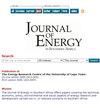在南非铂矿公司实施54兆瓦太阳能光伏电站的成本效益分析:案例研究
IF 0.6
4区 工程技术
Q4 ENERGY & FUELS
引用次数: 1
摘要
可靠和安全的能源供应是充足产出和经济增长的先决条件,对铂矿公司来说尤其如此。由于电价呈指数级增长,电力供应不足导致电力削减,以及碳税的引入,本研究通过实施一个54兆瓦的太阳能光伏电站来比较成本和收益。在对一家在勒斯滕堡铂带经营的南非铂矿公司的案例研究中,对同一20年期间的两种情况进行了比较。第一种情况是基于决定继续以传统方式从南非电力公司Eskom采购电力。第二个情景评估了54兆瓦太阳能光伏电站的实施情况。研究结果显示,该公司可以在20年内产生2 439 753兆瓦时的清洁能源,投资910 857 920兰特,节省563 205 994兰特(11%)的碳税,减少5 614 426 335兰特(10%)的电力成本。此外,安装太阳能光伏电站可以加强公司对保护环境的奉献精神,并通过雇用员工来安装和维护电站,创造就业机会。本文章由计算机程序翻译,如有差异,请以英文原文为准。
A cost-benefit analysis of implementing a 54 MW solar PV plant in a South African platinum mining company: A case study
A reliable and secure supply of energy is a prerequisite for adequate output and economic growth – especially in a platinum mining company. With exponential tariff increases, inadequate power supply leading to power cuts, and a carbon tax introduction, this study compared the costs with benefits by implementing a 54 MW solar photovoltaic (PV) plant. Two scenarios were compared over the same 20-year period in a case study of a South African platinum mining company operating in the platinum belt of Rustenburg. The first scenario was grounded upon the decision to proceed with the conventional manner of sourcing electricity from Eskom, South Africa’s power utility. The second scenario assessed the implementation of a 54 MW solar PV plant. The findings reveal that the company could generate 2 439 753 MWh of clean energy over 20 years with an investment of ZAR 910 857 920, giving a ZAR 563 205 994 (11%) carbon tax saving and a ZAR 5 614 426 335 (10%) reduction in electricity costs. Further, installing the solar PV plant could reinforce the company‘s dedication to protecting the environment and creating job opportunities through the employment of staff to install and maintain the plant.
求助全文
通过发布文献求助,成功后即可免费获取论文全文。
去求助
来源期刊

Journal of Energy in Southern Africa
ENERGY & FUELS-
CiteScore
3.00
自引率
0.00%
发文量
16
审稿时长
6 months
期刊介绍:
The journal has a regional focus on southern Africa. Manuscripts that are accepted for consideration to publish in the journal must address energy issues in southern Africa or have a clear component relevant to southern Africa, including research that was set-up or designed in the region. The southern African region is considered to be constituted by the following fifteen (15) countries: Angola, Botswana, Democratic Republic of Congo, Lesotho, Malawi, Madagascar, Mauritius, Mozambique, Namibia, Seychelles, South Africa, Swaziland, Tanzania, Zambia and Zimbabwe.
Within this broad field of energy research, topics of particular interest include energy efficiency, modelling, renewable energy, poverty, sustainable development, climate change mitigation, energy security, energy policy, energy governance, markets, technology and innovation.
 求助内容:
求助内容: 应助结果提醒方式:
应助结果提醒方式:


